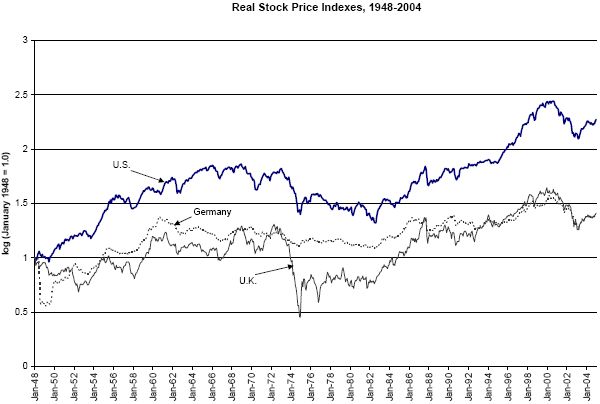What conditions lead to stock market booms and busts, and how does monetary policy relate to boom-bust transitions? In the May 2007 version of their paper entitled “Monetary Policy and Stock Market Booms and Busts in the 20th Century”, Michael Bordo, Michael Dueker and David Wheelock examine the relationship between monetary policy and stock market booms/busts in the U.S., U.K. and Germany during the 20th century. They define booms (busts) as periods of at least 36 (24) months from trough to peak (peak to trough) with at least 10% (20%) average annual increase (decrease) in real stock prices. Using monthly inflation-adjusted stock price indexes, they conclude that:
- Stock market booms tend to commence when real output (industrial production) growth is above average and inflation is low and end within a few months after an increase in inflation and monetary policy tightening. These relationships persist throughout the 20th century. (See the chart below.)
- Inflation strongly impacts market conditions, with positive (negative) shocks promoting busts (booms) in all three countries. Such shocks account for perhaps a third of the variance of U.S. real stock prices over the subsequent three years.
- Interest rate shocks also have a large impact, with unexpected increases (decreases) in long-term interest rates promoting stock market busts (booms).
- Both positive and negative output shocks affect U.S. real stock prices and market conditions positively, but these effects are transitory and lack statistical significance.
- Money supply growth rate shocks do not significantly impact the U.S. stock market.
The following chart, taken from the paper, shows real stock price indexes for the United States, United Kingdom and Germany for 1948-2004 normalized to 1.0 in January 1948. Returns stalled in the 1960s as inflation began to rise and were abysmal for the U.S. and U.K. during the high-inflation 1970s (Germany had relatively low inflation during the 1970s). Real stock prices rose in the early 1980s as inflation declined and in the late 1990s when inflation was low and stable.

In summary, inflation levels and expectations are key to equity market performance, and monetary policies that successfully manage inflation risks would promote stock market stability.